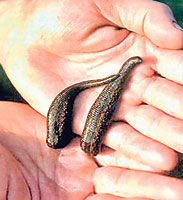Another little annelid has laid down its life in our service, and once again we fail to acknowledge its sacrifice. The story of the Australian bandit Peter Canon and the attenuated worm has been globe girdling for days now. Media reports have hailed the conscientious policing of the Tasmanian constabulary and the wonders that forensic science and DNA technology can perform. But the central character, without which there would have been no tale to tell, was only called names like “parasite” and “bloodsucker”, as if it was some sort of derivatives dealer or bonus-besotted banker.
This is shameful. It surely behoves us to show more gratitude to an animal, worm it might be, that has healed us of so many afflictions for so long. Leeches, members of the Hirudinae group of annelids, have been doing it for aeons, some 4,500 years in recorded history alone, starting in ancient Egypt. That’s since a full millennium and more before Tutankhamun became pharaoh, 2,530 years before Cleopatra cuddled up to a cobra.
Is this a parasite?
In its early internship years it treated only minor ailments like headaches and painful swellings like gumboils. But quite soon, it was on to arthritis, haemorrhoids, gout, gonorrhoea, and wounds that refused to heal. A little later, name any malady and if it needed blood to be extracted painlessly or kept flowing smoothly without clotting, the leech was there to help do the job. Today, untold numbers step into the breach and heal a multitude of maladies worldwide. Many millions do it in Europe and North America alone, every year. Are these mere bloodsuckers?
 |
Modern surgeons use them after major operations. They (surgeons not leeches) can suture severed arteries together relatively easily, after say heart or breast cancer surgery. But leeches are used to maintain blood flow in the more slender veins. Plastic surgeons have found them (leeches this time) invaluable to keep skin and tissue grafts alive. Micro surgeons use them after limb transplants. The United States Food and Drugs Administration approved the use of leeches, as a “medical device”, several years ago.
The secret of the leech’s success is in its saliva. It contains chemicals that thin blood and (importantly) deadens the pain of the bite. Other animals have similar saliva. But what have they done for us? The hookworm makes us itch. The ubiquitous tick infests our furry domestic pets. The vampire bat kills our deer and cattle. All the leech asks for is a little blood painlessly taken over only a matter of minutes, after which it goes away. In exchange it has given us health and, if we stop to think of it, happiness.
And now the case of Peter Alec Canon has extended its range of services. Simply told, Canon and an accomplice strongarmed an old lady, living alone in the backwoods of Tasmania, tied her up and stole her modest savings. On the way to her house, however, an alert annelid attached itself to Canon. Having stealthily supped its fill, it detached itself and dropped in front of the lady’s refrigerator where crime scene investigators (CSI Tasmania?) could hardly fail to spot it.
Sure enough they did. They took it back to the police laboratory, extracted the blood, obtained a DNA profile, and stored it in their database of unsolved cases. That was in 2001. Seven years later, Canon was charged on a drug offence, and police found his deoxyribonucleic acid matched the stored data. Yes it was good policing and forensic science is impressive. But let us not forget that it was the leech that did the spadework, and the leech it was that died. |

